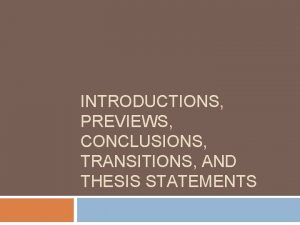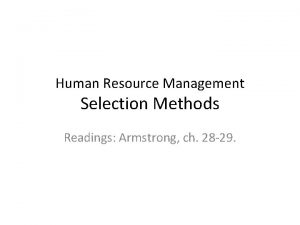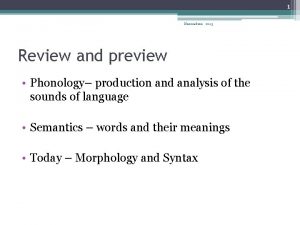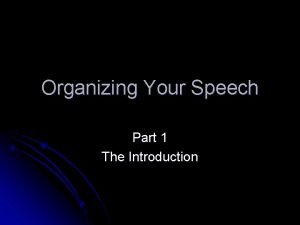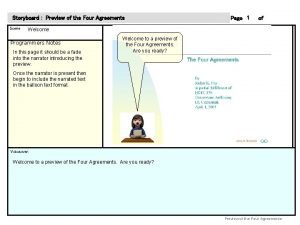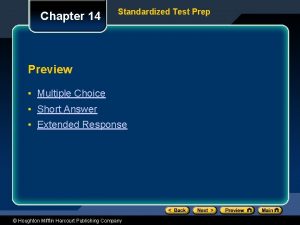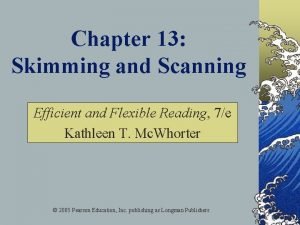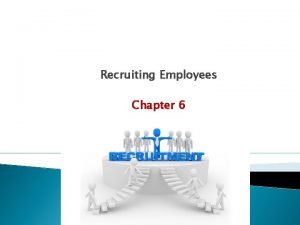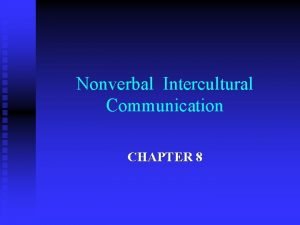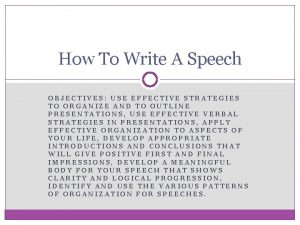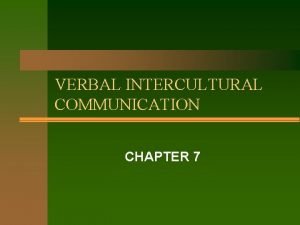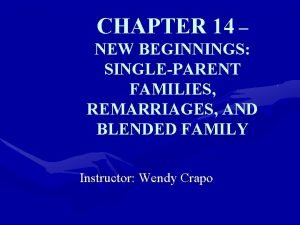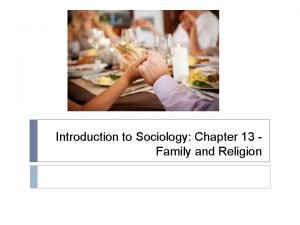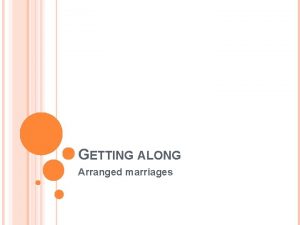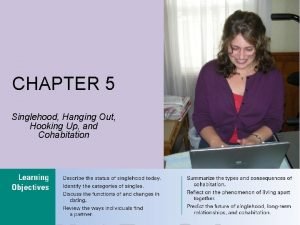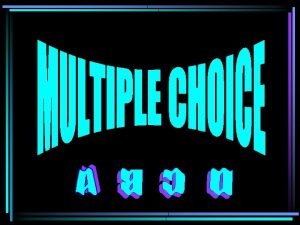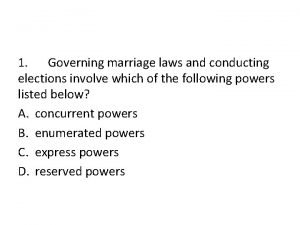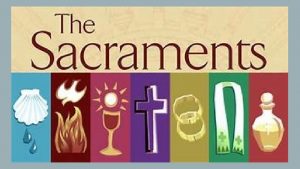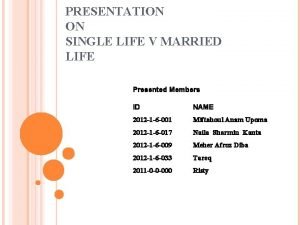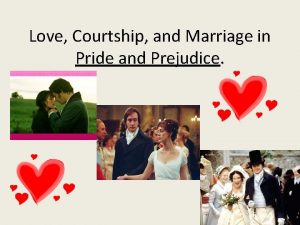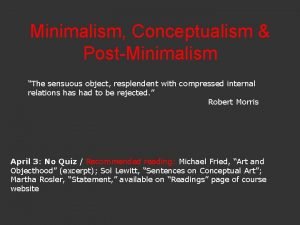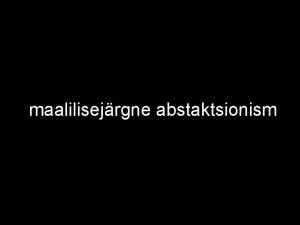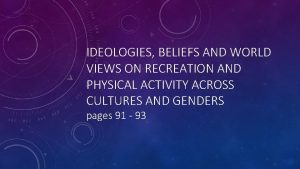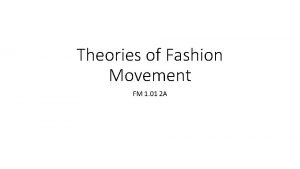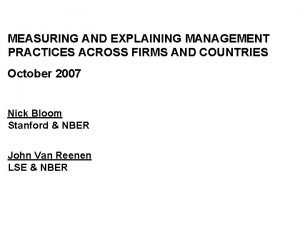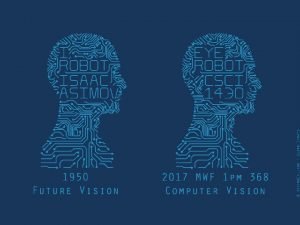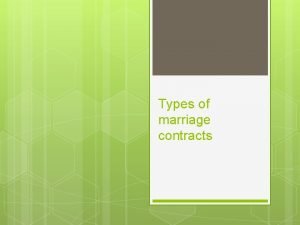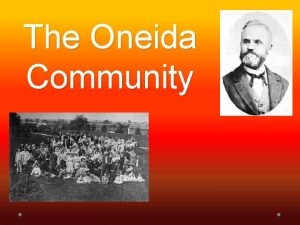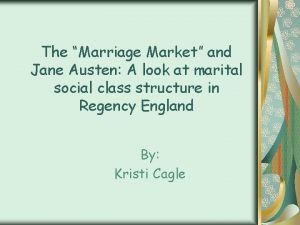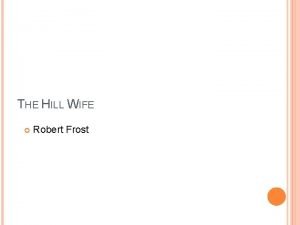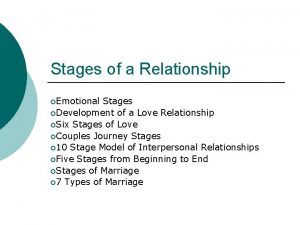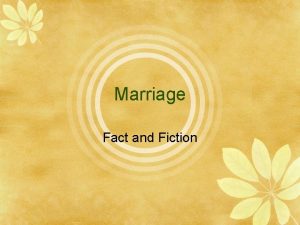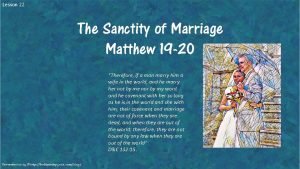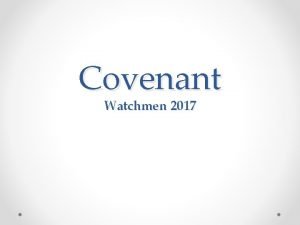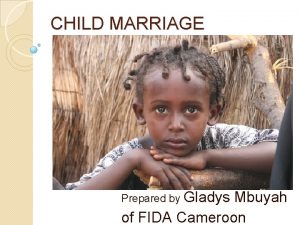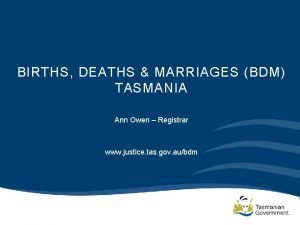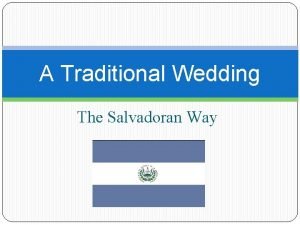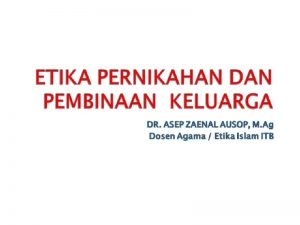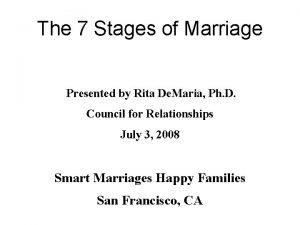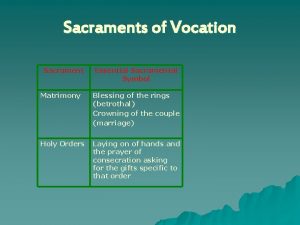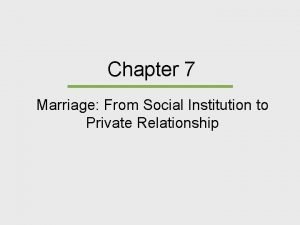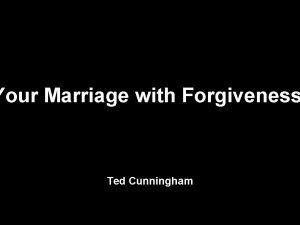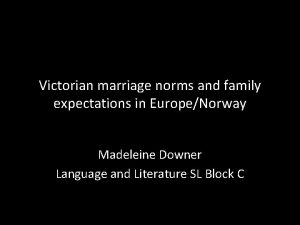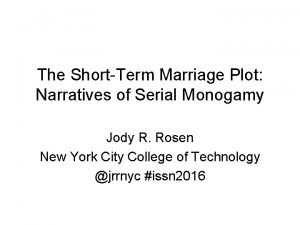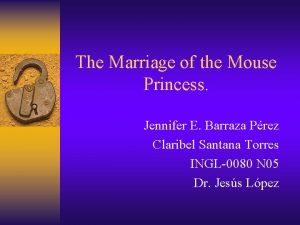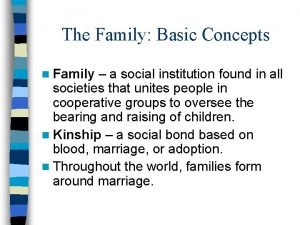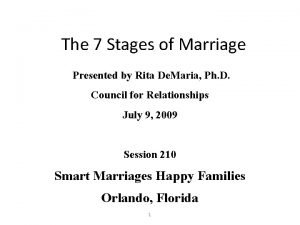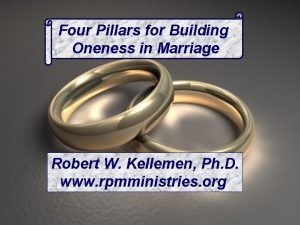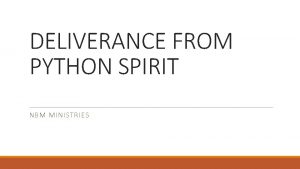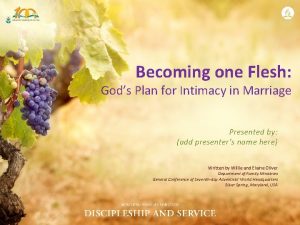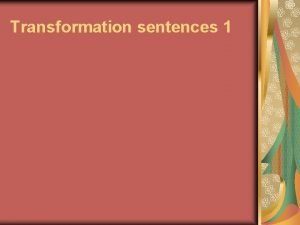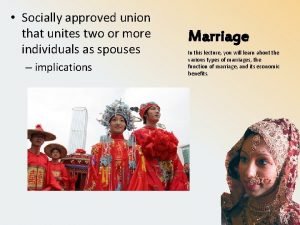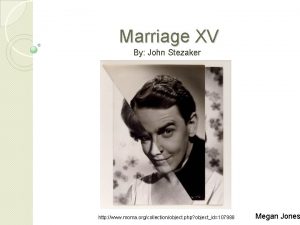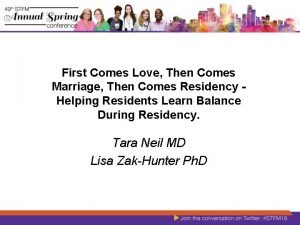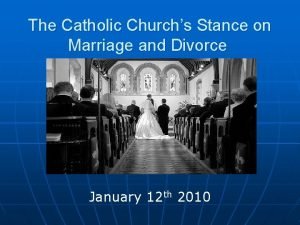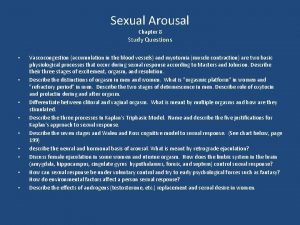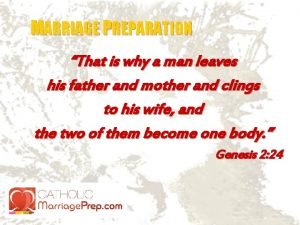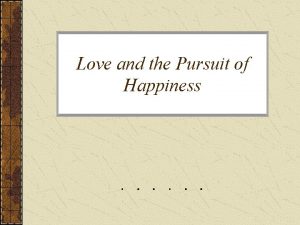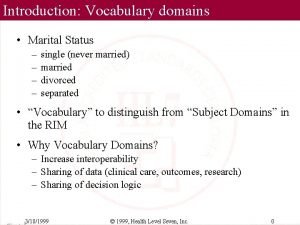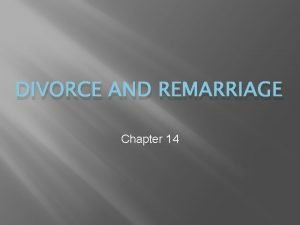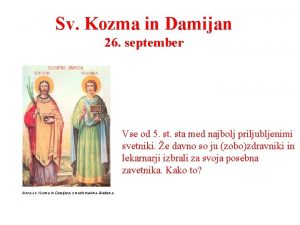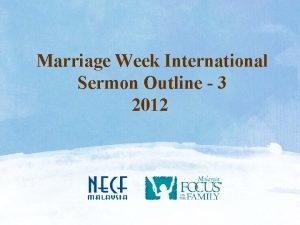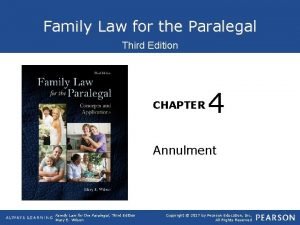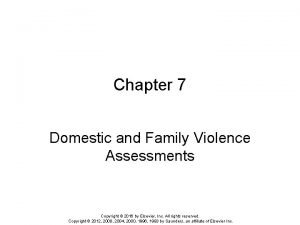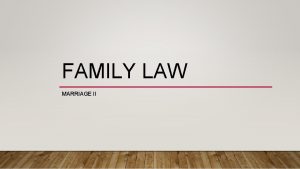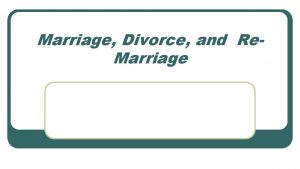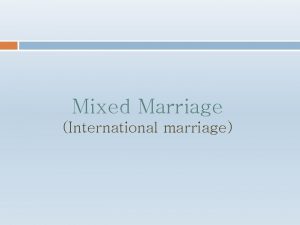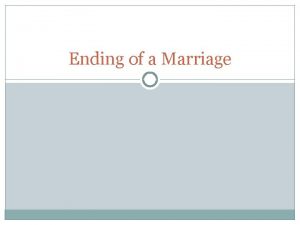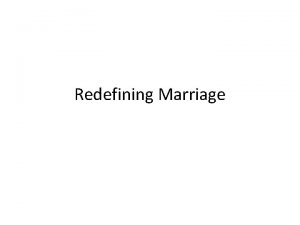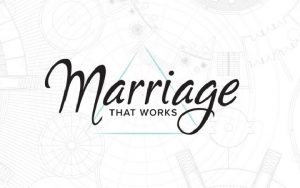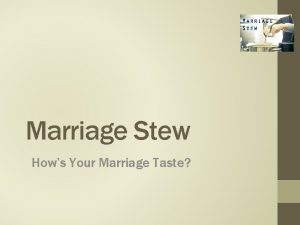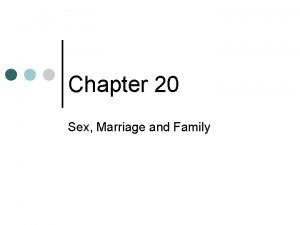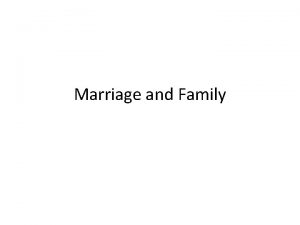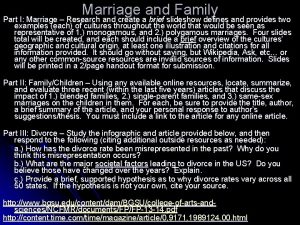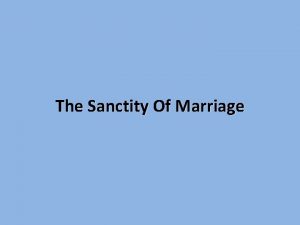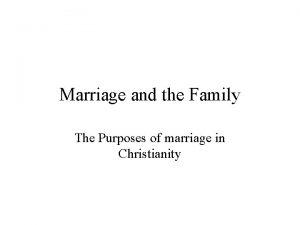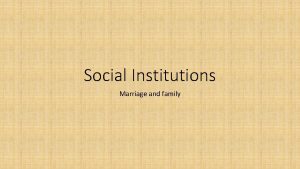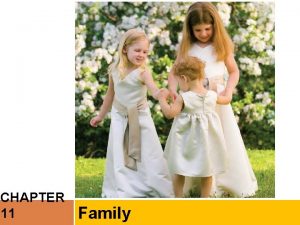Chapter Preview Section 1 Family and Marriage Across













































































































































- Slides: 141


Chapter Preview Section 1: Family and Marriage Across Cultures Section 2: Theoretical Perspectives and the Family Section 3: Family and Marriage in the United States Section 4: Changes in Marriage and Family

Chapter Preview · Section 1 Family and Marriage Across Cultures (pages 348– 356) In all societies, the family has been the most important institution. It produces new generations, socializes the young, provides care and affection, regulates sexual behavior, transmits social status, and provides economic support.

Chapter Preview · Section 2 Theoretical Perspectives and the Family (pages 357– 362) The family is the very core of human social life. It is not surprising that each of the major perspectives focuses on the family. Functionalism emphasizes the benefits of the family for society. The conflict perspective looks at why males dominate in the family structure. Symbolic interactionism studies how the family socializes children and promotes the development of self-concept.

Chapter Preview · Section 3 Family and Marriage in the United States (pages 363– 370) Modern marriages are based primarily on love, but there are many reasons for marrying—and as many reasons given for divorce. Although the American family provides social and emotional support, violence in this setting is not uncommon. Child abuse, spouse abuse, and elder abuse are serious problems in too many American families.

Chapter Preview · Section 4 Changes in Marriage and Family (pages 371– 380) Many new patterns of marriage and family living have emerged in the United States. In spite of these new arrangements, the traditional nuclear family is not going to be replaced on a broad scale.


In all societies, the family has been the most important of all social institutions. It produces new generations, socializes the young, provides care and affection, regulates sexual behavior, transmits social status, and provides economic support.

• • • family marriage nuclear family extended family patrilineal matrilineal bilateral patriarchy matriarchy equalitarian patrilocal • • • matrilocal neolocal monogamy polygyny polyandry exogamy incest taboo endogamy homogamy heterogamy

Do you feel your family has played a large role in your life? A. Very much so B. Somewhat C. Not very much D. Not at all A. B. C. D. A B C D

Defining the Family • Family is defined as a group of people related by marriage, blood, or adoption. • The family has the greatest impact on individual behavior. • The family we are born into is called the family of orientation. • The family of procreation is established upon marriage.

Defining the Family (cont. ) • Marriage is a legal union between a man and a woman based on mutual rights and obligations.

What reasons define a family in today’s society? A. Parents and children B. People related by blood C. Marriage D. All of the above A. B. C. D. A B C D

Two Basic Types of Families • The nuclear family—parents or parent and any children. • The extended family—two or more adult generations of the same family whose members share economic resources and live in the same household. • The family structure has changed over the years depending on the type of society.

In the earliest societies, how important was extended family for survival? A. Very important B. Somewhat important C. Not very important D. Not important at all A. B. C. D. A B C D

Patterns of Family Structure • Depending on the arrangement, inheritance varies: – Patrilineal—descent and inheritance are passed from the father to his male descendents. – Matrilineal—descent and inheritance are transmitted from the mother to her female descendents. – Bilateral—descent and inheritance are passed equally through both parents.

Patterns of Family Structure (cont. ) • Authority also differs: – Patriarchy—the oldest man living in the household has authority over the rest of the family. – Matriarchy—the oldest woman living in the households authority. – Equalitarian—authority is split evenly between husband wife.

Patterns of Family Structure (cont. ) • Where newlyweds live also varies depending on the culture: – Patrilocal—they live near the husband’s family. – Matrilocal—they live near the wife’s family. – Neolocal—married couples establish residences of their own.

How many patterns of family structures are there within the United States? A. Three B. Six C. Nine D. Twelve A. B. C. D. A B C D

Marriage Arrangements • Monogamy is the marriage of one man to one woman. • Serial monogamy—having several husbands or wives, but being married to only one at a time. • Polygamy is the marriage of one male or female to more than one person at a time. Families/Marriages

Marriage Arrangements (cont. ) • Polygyny—the marriage of one man to two or more women at the same time. • Polyandry—the marriage of one woman to two or more men at the same time. Percentage of Women Aged 15– 19 Ever Married

Do you feel that marriage is a necessary institution? A. Very much so B. Somewhat C. A little D. Not at all A. B. C. D. A B C D

Choosing a Mate • Exogamy refers to mate-selection norms requiring individuals to marry someone outside their kind or group. • Incest taboos forbid marriage between certain kinds of relatives. • Endogamy involves mate-selection norms that require individuals to marry within their own kind. Mixed Marriages and Intergroup Married Couples in the United States

Choosing a Mate (cont. ) • Mixed marriages are becoming more frequent. • Class lines are also being crossed. • Norms separating age and religion are weakening. • People tend to marry those with social characteristics similar to their own, also referred to as homogamy.

Choosing a Mate (cont. ) • However, heterogamy, a marriage between partners who have dissimilar characteristics, is rising.

The following are reasons for heterogamous marriages EXCEPT A. Traditional barriers are being crossed. B. Class lines are being crossed. C. The laws preventing heterogamy have changed. D. T. V. and film have fostered this change. A. B. C. D. A B C D


The family is the very core of human social life. It is not surprising that each of the major perspectives focuses on the family. Functionalism emphasizes the benefits of the family for society. The conflict perspective looks at the reasons males dominate in the family structure. Symbolic interactionism studies the way the family socializes children and promotes the development of self-concept.

• socioemotional maintenance

Do you agree with the following statement: “Males dominate the family structure? ” A. Always B. Sometimes C. Never D. Not sure A. B. C. D. A B C D

Functionalism • Functions of the family: – By being role models and through training and education, the family begins and continues the process of socialization in each new stage of development. • Socioemotional maintenance—the family is the one place in society where an individual is unconditionally loved and accepted.

Functionalism (cont. ) • The family provides an orderly means for producing new members. • There are norms surrounding sex, and it is up to the family to enforce them. • Families provide economic resources that open and close occupational doors. • They also pass on values that affect social status.

Functionalism (cont. ) • One or more adult member of each family works to provide what is needed to survive. American Youths Grade Their Parents

Given these functions, do you think that most families successfully fulfill them? A. Yes B. No C. Not sure D. Sometimes A. B. C. D. A B C D

Conflict Theory • Conflict theorists focus on the way family members compete and cooperate. • According to this theory, males are dominant and in control; females have traditionally been expected to be submissive helpers. • Feminists tend to view the family from the conflict perspective—and claim that the family structure is the source of inequality between men and women.

How strongly do you feel that the family structure represses women? A. Very strongly B. Somewhat strongly C. Not very strongly D. Not strongly at all A. B. C. D. A B C D

Symbolic Interactionism • A key to understanding behavior within the family lies in the interactions among family members and the meanings that members assign to these interactions. • Children develop self-concepts and learn to empathize within and outside of the home. • Relationships within the family are constantly changing. Perspectives on Family

What are some ways that relationships within your family have changed over the years? A. Responsibilities B. Personalities C. Self-concept D. All of the above A. B. C. D. A B C D


Modern marriages are based primarily on love, but there are many reasons for marrying—and as many reasons for divorce. Although the American family provides social and emotional support, violence in this setting in not uncommon. Child abuse and spouse abuse are serious problems in too many American families.

• marriage rate • divorce rate

Why are many marriages not functional? A. Violence B. Abuse C. Money A. A B. B C. C

The Nature of the American Family • Families are: – Nuclear – Bilateral – Democratic – Neolocal – Monogamous

Do you agree with the above characteristics? A. Agree B. Disagree C. Not sure A. A B. B C. C

Romantic Love and Marriage • Other reasons for marriage than romantic love: – Desire to enter a powerful family – Desire to advance in a career – Conformity Marriage Rates

Romantic Love and Marriage (cont. ) • Love is an important start to a marriage, but a couple must build a relationship that goes beyond romantic love. • The marriage rate—the number of marriages per year for every thousand members of the population—has fallen more than fifty percent since the post WWII era. Divorce and Marriage Rates: 1940– 2005

What are some reasons for marriage other than romantic love? A. To enter a powerful family B. To advance a career C. Conformity D. Pressure A. B. C. D. A B C D

Divorce • The divorce rate is the number of divorces per year for every one thousand members of the population. • The recent divorce rate has been in a slow, but steady decline.

Divorce (cont. ) • The individual causes of divorce are: – the age of people when they married. – the number of years the partners have been married. – the nature and quality of the relationship. Median Age of First Marriage

Divorce (cont. ) • Societal factors influencing divorce: – The divorce rate rises during economic prosperity and goes down when times are hard. – The rise of the divorce rate after 1960 followed the growing up of the babyboom generation.

Divorce (cont. ) – The increasing financial independence of women means they are more willing to end bad marriages. – American values and attitudes about marriage and divorce are changing.

Divorce (cont. ) • The recent decline in divorce may continue because: – the average at first marriage is increasing. – the average of the population of the U. S. is increasing as baby boomers grow older. – American couples are having fewer children who are spaced farther apart.

Which reason do you feel will make a marriage last? A. The later the age upon marriage B. The longer the marriage C. The more respect and flexibility exists between the partners D. All of the above A. B. C. D. A B C D

Family Violence • Domestic violence occurs at all social class levels. • Statistics: – Almost one-quarter of adults in the U. S. report having been physically abused as children. – One of every four girls and one in ten boys are victims of sexual aggression.

Family Violence (cont. ) – At least four million women are battered by their husbands each year. – Over four thousand are beaten to death. – Most of the violence committed by women involves self protection or retaliation. Events of Domestic Violence Against Women in Selected Countries

Family Violence (cont. ) • Verbal and psychological abuse, as well as neglect, are also prominent in many families. • The most frequent and tolerated type of violence is sibling violence. • Little is known about abuse of the elderly.

What are the reasons that sibling violence is the most tolerated and frequent? A. Rivalry B. Jealousy C. Disagreements over personal possessions D. All of the above A. B. C. D. A B C D


Many new patterns of marriage and family living have emerged in the United States. They include blended families, single-parent families, child-free families, cohabitation, same-sex domestic partners, and families with boomerang children. In spite of these new arrangements, the traditional nuclear family is not going to be replaced on any broad scale.

• blended families • adolescents • dual-employed marriages • cohabitation • boomerang kids

What other types of families exists A. A outside of the nuclear family? B. B A. Blended families C. C D. B. D Single-parent families C. Child-free families D. All of the above

Blended Families • A blended family is formed when at least one of the partners in a marriage has been married before and has a child or children from the previous marriage. • About 32% of households in the U. S. contain biologically unrelated individuals.

Blended Families (cont. ) • Three major problems facing blended families: – Money difficulties – Stepchildren antagonism – Unclear roles

What major problems face blended A. A families? B. B A. Money difficulties C. C D. B. D Stepchildren’s antagonism C. Unclear roles D. All of the above

Single-Parent Families • One out of four American families is a single-parent family. • Most of these are headed by women. • More affluent unmarried women are choosing to have children and care for them alone. • Approximately 28% of America’s children (people under 18) live in households with one parent.

Single-Parent Families (cont. ) • Adolescents (ages 12– 17) who live with only one parent or a stepparent are more likely to display deviant behavior. Percentage of Single-Parent Families: 1970– 2003

Do you feel that one of the reasons that most single-parent households are led by women is that courts tend to award custody to the mother over the father in cases such as divorce? A. Very much so B. Somewhat C. Not very much D. Not at all A. A B. B C. C D. D

Childless Marriages • Around 19% of American women who have ever been married did not have children in 2002, which shows a 4% increase since 1970. • Reasons for choosing not to have children are varied, including aspects such as career, moral issues, and physical problems with becoming pregnant.

How important is it to you to have children? A. Very important B. Somewhat important C. Not very important D. Not important at all A. A B. B C. C D. D

Dual-Employed Marriages • Dual-employed marriages—Special strains are put on a marriage when both parents work outside the home. • Drawbacks: – Women work about 15 hours a week more than men in this situation. – They must cope with role conflict.

Dual-Employed Marriages (cont. ) – Men also feel the effects of role conflict and excessive demands on their time. – Men may have issues with confidence if the wife earns more. • Advantages: – The psychological well-being of women has improved.

Dual-Employed Marriages (cont. ) • Advantages: – Work outside the home provides a social and emotional cushion for women when their children leave home. – Other members of the family benefit from a wife’s employment.

Dual-Employed Marriages (cont. ) – Sons and daughters can view their mother as a role model regarding employment. – Men can gain freedom from the strain of being the sole provider. – Men can feel more free to change jobs. – They can also continue their education.

Do you feel there is a positive side to dual employment in a marriage? A. Very much so B. Somewhat C. Not very much D. Not at all A. A B. B C. C D. D

Cohabitation • Cohabitation is a situation when someone lives with another person in a marriage-like arrangement without the legal obligations and responsibilities of a formal marriage.

Cohabitation (cont. ) • Cohabitation is on the rise, but the statistics are not encouraging: – Only about 25% of cohabitating couples stay together more than 4 years. – There is a high rate of abuse among cohabitating women. – Premarital cohabitation is associated with a higher risk of divorce.

Do you agree with the following statement: “Cohabitating couples tend not to fare as well once they are married? ” A. Always B. Sometimes C. Never D. Not sure A. A B. B C. C D. D

Same-Sex Domestic Partners • Gay people make up about 10% of the U. S. population, and account for 6% of American households. • They are still fighting to achieve the same benefits as legally married couples.

What are some of the reasons that gay activists and their supporters have fought to achieve the same rights for gay couples as married couples? A. The tax benefits B. Spouse’s health insurance policy C. Both A & B D. None of the above A. A B. B C. C D. D

Single Life • More than 29 million Americans over the age of 15 now live alone, an increase of 61% since 1980. • The implication is that many young adults wish to expand their “freedom” after leaving home and are unwilling to rush into the responsibilities of marriage and parenthood.

Do you feel that living alone for awhile is healthy? A. Very much so B. Somewhat C. Not very much D. Not at all A. A B. B C. C D. D

Boomerang Kids • Boomerang kids—This term refers to young adults who either leave home and return or stay at home and live with parents. • More than 26% of adults 18 -34 now live with one or both parents.

Boomerang Kids (cont. ) • Reasons for living at home: – Young adults are marrying later. – They are continuing their education. – They return home after completing their education due to the cost of living. – Young adults return home after a divorce.

Boomerang Kids (cont. ) • Consequences: – Expense of having someone else move in, especially if he/she does not help financially. – Lack of privacy for the parents. – The adult child might feel like a burden and must give up some freedom. • However, most families seem to adjust well to this situation.

How strongly do you feel about adult children who might need to move back in with their parents? A. Very strongly B. Somewhat strongly C. Not very strongly D. Not strongly at all A. A B. B C. C D. D

Looking Forward • Around 90% of men and women in the U. S. marry sometime during their lives and the nuclear family remains the most popular choice. • However, the family is changing. • The traditional household accounts for less than one-fourth of all American households.

Looking Forward (cont. ) • The trend toward more working parents, with its positive and negative sides, is likely to continue.

What type of family (or lack thereof) do you envision for yourself? A. Blended Families B. Single-Parent Families C. Dual-Employed Marriages D. Cohabitation A. A B. B C. C D. D



Mixed Marriages and Intergroup Married Couples in the United States Source: American Demographics, Population Reference Bureau, 1998; Miliken Institute, 2001.




Divorce and Marriage Rates: 1940– 2005 Source: National Vital Statistics Reports; Statistical Abstract of the United States.

Median Age at First Marriage Source: The World Almanac Book of Facts, 2005.

Events of Domestic Violence Against Women in Selected Countries Source: World Health Organization, 2002.

Events of Domestic Violence Against Women in Selected Countries Source: World Health Organization, 2002.

Percentage of Single-Parent Families: 1970– 2003 Source: U. S. Bureau of the Census, Statistical Abstract of the United States, 2004– 2005.

Marriage Rates Source: National Center for Health Statistics, Division of Vital Statistics, 2005.

Percentage of Women Aged 15– 19 Ever Married Source: United Nations Statistics Division, 2005.

Sociology Chapter Transparencies Economy and Family Structure Major Characteristics of Extended and Nuclear Families Family Types by Race and Latino Origin Births to Unmarried Women, by State Children Living with Father Working Fulltime and Mother not in the Labor Force 1940– 90 Parental Living Arrangements of Children, 1980– 2002 Child Abuse Reported, 1962– 2003








family a group of people related by marriage, blood, or adoption

marriage a legal union based on mutual rights and obligations

nuclear family structure composed of one or both parents and children

extended family two or more adult generations of the same family whose members share economic resources and a common household

patrilineal descent and inheritance are passed through the male line

matrilineal descent and inheritance are passed through the female line

bilateral descent and inheritance are passed equally through both parents

patriarchy the pattern in which the oldest man living in the household has authority over the rest of the family members

matriarchy the pattern in which the oldest woman living in the household has authority over all other family members

equalitarian family structure in which authority is evenly shared between the husband wife

patrilocal refers to the pattern in which married couples live with or near the husbands’ parents

matrilocal refers to the pattern in which married couples live with or near the wives’ parents

neolocal refers to the pattern in which newly married couples set up their own households

monogamy a marriage consisting of one man and one woman

polygamy the marriage of a male or female to more than one person at a time

polygyny the marriage of one man to two or more women at the same time

polyandry the marriage of one woman to two or more men at the same time

exogamy the practice of marrying outside one’s group

incest taboo a norm forbidding marriage between close relatives

endogamy marriage within one’s own group as required by social norms

homogamy the tendency to marry someone similar to oneself

heterogamy marriage between people with differing social characteristics

socioemotional maintenance provision of acceptance and support

marriage rate the number of marriages per year for every one thousand members of a population

divorce rate the number of divorces per year for every one thousand members of the population

blended family a family formed when at least one of the partners in a marriage has been married before and has a child or children from a previous marriage

adolescents youths from the ages of twelve to seventeen

dual-employed marriages in which both spouses work outside the home

cohabitation a marriagelike living arrangement without the legal obligations and responsibilities of formal marriage

boomerang kids adult children who return to the home of origin or who continue to live with parents

To use this Presentation Plus! product: Click the Forward button to go to the next slide. Click the Previous button to return to the previous slide. Click the Home button to return to the Chapter Menu. Click the Transparency button to access the transparencies that are relevant to this chapter. Click the Return button in a feature to return to the main presentation. Click the Sociology Online button to access online textbook features. Click the Exit button or press the Escape key [Esc] to end the chapter slide show. Click the Help button to access this screen. Links to Presentation Plus! features such as the Figures, Time Lines, Snapshot of America, World View and others are located at the bottom of relevant screens.

 Apply for graduation usu
Apply for graduation usu 3-point thesis statement examples
3-point thesis statement examples Summary thesis statement
Summary thesis statement What is a preview statement
What is a preview statement Classic trio' of selection techniques
Classic trio' of selection techniques Review and preview
Review and preview Realistic job preview pros and cons
Realistic job preview pros and cons Test prep preview
Test prep preview Test prep preview
Test prep preview Test prep preview
Test prep preview Test prep preview
Test prep preview Sccm technical preview
Sccm technical preview Startling statement introduction examples
Startling statement introduction examples Test prep preview
Test prep preview Nnn preview
Nnn preview The selection preview
The selection preview Test prep preview
Test prep preview The four agreements preview
The four agreements preview Test prep preview
Test prep preview Perintah print preview kita jalankan dari menu
Perintah print preview kita jalankan dari menu Test prep preview
Test prep preview Skimming newspaper
Skimming newspaper 1984 book preview
1984 book preview Yandex film ru
Yandex film ru Nút lệnh print preview nằm ở đâu
Nút lệnh print preview nằm ở đâu Tams college acceptance
Tams college acceptance Disadvantages of realistic job preview
Disadvantages of realistic job preview Multi-channeled definition in communication
Multi-channeled definition in communication Preview speech
Preview speech Verbal intercultural communication
Verbal intercultural communication Nnn image preview
Nnn image preview Menu collections pane di windows movie maker berguna untuk
Menu collections pane di windows movie maker berguna untuk Intimate family chapter 2
Intimate family chapter 2 Conclusion on topic family
Conclusion on topic family Chapter 10 section 1 meiosis worksheet answer key
Chapter 10 section 1 meiosis worksheet answer key Periodic table families
Periodic table families Characteristics of single parent family
Characteristics of single parent family Hypergamous marriage
Hypergamous marriage Marriage and divorce presentation
Marriage and divorce presentation Love and marriage
Love and marriage What is the theme in marriage is a private affair
What is the theme in marriage is a private affair Endogamy and exogamy marriage
Endogamy and exogamy marriage Arranged marriage advantages and disadvantages
Arranged marriage advantages and disadvantages Child marriage advantages and disadvantages
Child marriage advantages and disadvantages Monica ribeiro
Monica ribeiro Vardamo
Vardamo Governing marriage laws and conducting elections involve
Governing marriage laws and conducting elections involve Form of eucharist
Form of eucharist Single life or married life which is better
Single life or married life which is better Lecture on love courtship and marriage
Lecture on love courtship and marriage What are the greatest strains on walter and ruth's marriage
What are the greatest strains on walter and ruth's marriage Theme of love in a doll's house
Theme of love in a doll's house Hans haacke
Hans haacke The marriage of reason and squalor
The marriage of reason and squalor What is a full section view
What is a full section view What is the definition of chemical potential energy
What is the definition of chemical potential energy Law 47
Law 47 Single family housing section 504 repair pilot program
Single family housing section 504 repair pilot program Recreational activities across cultures and genders
Recreational activities across cultures and genders Within run and across run meaning
Within run and across run meaning Academic english reading and writing across the disciplines
Academic english reading and writing across the disciplines Trickle across theory fashion
Trickle across theory fashion Einstein smiled and put his arm across my shoulder
Einstein smiled and put his arm across my shoulder Management practices across firms and countries
Management practices across firms and countries Feature
Feature Chapter 4 work and energy section 1 work and machines
Chapter 4 work and energy section 1 work and machines Nikah shigar
Nikah shigar John humphrey noyes
John humphrey noyes Marriage market jane austen
Marriage market jane austen The hill wife
The hill wife Knapps relational model
Knapps relational model Dowry ancient rome
Dowry ancient rome When was the marriage of figaro composed
When was the marriage of figaro composed Forms of marriage
Forms of marriage Marriage is the path to chastity
Marriage is the path to chastity Marriage is a private affair conflict
Marriage is a private affair conflict What is marriage
What is marriage Agape love definition
Agape love definition Let me not to the marriage of true minds
Let me not to the marriage of true minds Sanctity of marriage definition
Sanctity of marriage definition Child marriage definition
Child marriage definition Thailand bride price
Thailand bride price What is a covenant marriage
What is a covenant marriage Beriyth
Beriyth Did gladys aylward marry
Did gladys aylward marry Heterogamy marriage
Heterogamy marriage Arranged marriage advantages
Arranged marriage advantages Tasmania births deaths and marriages
Tasmania births deaths and marriages Traditional wedding food
Traditional wedding food Marriage are made in heaven
Marriage are made in heaven Visi dalam pernikahan
Visi dalam pernikahan Forced marriage definition
Forced marriage definition The 7 stages of marriage
The 7 stages of marriage Matrimony sacrament symbols
Matrimony sacrament symbols Zawaj misyar
Zawaj misyar Marriage sermon outline
Marriage sermon outline Functions of marriage
Functions of marriage What is institutional marriage
What is institutional marriage Bilal ibn rabah title
Bilal ibn rabah title Anne hathaway shakespeare
Anne hathaway shakespeare Traditional marriage algorithm
Traditional marriage algorithm Ted cunningham marriage
Ted cunningham marriage Victorian era marriage expectations
Victorian era marriage expectations Serial monogamy
Serial monogamy Princess jenifer feet
Princess jenifer feet Concept about marriage
Concept about marriage 7 stages of marriage
7 stages of marriage Same sex marriage definition
Same sex marriage definition Group marriage example
Group marriage example 4 pillars of marriage
4 pillars of marriage Python spirit bible
Python spirit bible Becoming one intimacy in marriage
Becoming one intimacy in marriage Child marriage meaning
Child marriage meaning She has probably found a new job
She has probably found a new job Cousin marriage benefits
Cousin marriage benefits Same sex marriage
Same sex marriage What does purity mean in the bible
What does purity mean in the bible Father's day paul durcan
Father's day paul durcan John stezaker marriage
John stezaker marriage Be like sarah
Be like sarah Marriage rededication prayer
Marriage rededication prayer Marriage definition
Marriage definition First comes love then comes marriage
First comes love then comes marriage What is marriage
What is marriage Effects of lack of sex in marriage
Effects of lack of sex in marriage Catholic marriage prep answer key
Catholic marriage prep answer key Marriage doesn't guarantee happiness
Marriage doesn't guarantee happiness What civil status
What civil status Igcse sociology family notes
Igcse sociology family notes Malachi 2 14-16
Malachi 2 14-16 How to know your marriage is over
How to know your marriage is over Republican motherhood apush
Republican motherhood apush Sv kozma in damijan
Sv kozma in damijan Paul teaching on marriage
Paul teaching on marriage Marriage week international
Marriage week international Ungodly marriage
Ungodly marriage Fraud in marriage
Fraud in marriage Stable marriage python
Stable marriage python Marriage rite of passage
Marriage rite of passage Routine, universal screening for domestic violence means
Routine, universal screening for domestic violence means Priorities in a healthy relationship
Priorities in a healthy relationship Full sectional view
Full sectional view



